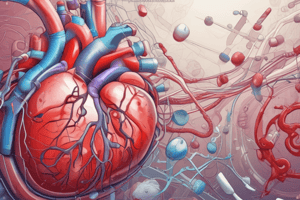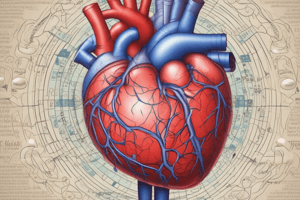Podcast
Questions and Answers
Nitroglycerin is a prodrug that is converted by mitochondrial aldehyde dehydrogenase to give nitric oxide.
Nitroglycerin is a prodrug that is converted by mitochondrial aldehyde dehydrogenase to give nitric oxide.
True (A)
Propranolol is a selective β-agonist used for the treatment of glaucoma.
Propranolol is a selective β-agonist used for the treatment of glaucoma.
False (B)
Propranolol's route of administration is mainly intravenous due to its high first-pass metabolism.
Propranolol's route of administration is mainly intravenous due to its high first-pass metabolism.
False (B)
Nitroglycerin causes blood vessels dilation by inhibiting smooth muscle contraction.
Nitroglycerin causes blood vessels dilation by inhibiting smooth muscle contraction.
Heparin has a longer half-life compared to Propranolol.
Heparin has a longer half-life compared to Propranolol.
Digitalis is commonly used to treat hypertension and bronchoconstriction.
Digitalis is commonly used to treat hypertension and bronchoconstriction.
Digitalis is extracted from the sunflower plant.
Digitalis is extracted from the sunflower plant.
CCF stands for Congenital Cardiac Failure.
CCF stands for Congenital Cardiac Failure.
Digoxin acts mainly on the lungs in the treatment of congestive cardiac failure.
Digoxin acts mainly on the lungs in the treatment of congestive cardiac failure.
Aspirin prevents clotting of blood by promoting platelet activation and aggregation.
Aspirin prevents clotting of blood by promoting platelet activation and aggregation.
Digoxin is excreted via the liver.
Digoxin is excreted via the liver.
The onset of aspirin when taken orally is typically 1-2 hours.
The onset of aspirin when taken orally is typically 1-2 hours.
Warfarin is structurally related to vitamin C.
Warfarin is structurally related to vitamin C.
Heparin-induced Thrombocytopenia (HIT) always leads to amputations.
Heparin-induced Thrombocytopenia (HIT) always leads to amputations.
Aspirin inhibits blood clot formation by inactivating clotting factors.
Aspirin inhibits blood clot formation by inactivating clotting factors.
Heparin is safe to use in pregnancy due to its low therapeutic index.
Heparin is safe to use in pregnancy due to its low therapeutic index.
The antidote for heparin-induced thrombocytopenia is vitamin K.
The antidote for heparin-induced thrombocytopenia is vitamin K.
Warfarin-induced skin necrosis is most likely to occur in postmenopausal obese women.
Warfarin-induced skin necrosis is most likely to occur in postmenopausal obese women.
Propranolol increases heart rate and force of contraction by inhibiting smooth muscle contraction.
Propranolol increases heart rate and force of contraction by inhibiting smooth muscle contraction.
Nitroglycerin dilates blood vessels by promoting smooth muscle relaxation.
Nitroglycerin dilates blood vessels by promoting smooth muscle relaxation.
Digitalis is commonly used for the treatment of glaucoma.
Digitalis is commonly used for the treatment of glaucoma.
Heparin has a shorter half-life compared to Nitroglycerin.
Heparin has a shorter half-life compared to Nitroglycerin.
Warfarin is structurally related to vitamin K.
Warfarin is structurally related to vitamin K.
Aspirin prevents clotting of blood by inactivating clotting factors.
Aspirin prevents clotting of blood by inactivating clotting factors.
Aspirin is used at low doses to inhibit PGI2 formation in endothelium.
Aspirin is used at low doses to inhibit PGI2 formation in endothelium.
Heparin and Low Molecular Weight Heparin (LMWH) prevent clotting of blood by activating clotting factors.
Heparin and Low Molecular Weight Heparin (LMWH) prevent clotting of blood by activating clotting factors.
Warfarin is a vitamin K antagonist that prevents the synthesis of clotting factors II, VII, IX, and X.
Warfarin is a vitamin K antagonist that prevents the synthesis of clotting factors II, VII, IX, and X.
Heparins are primarily given intramuscularly.
Heparins are primarily given intramuscularly.
The antidote for heparin-induced thrombocytopenia is protamine sulphate.
The antidote for heparin-induced thrombocytopenia is protamine sulphate.
Warfarin-induced skin necrosis is most likely to occur in young males.
Warfarin-induced skin necrosis is most likely to occur in young males.
Digoxin is the main drug in the class of Cardiac Glycosides.
Digoxin is the main drug in the class of Cardiac Glycosides.
Digoxin primarily acts on the heart and is used in the treatment of congestive cardiac failure (CCF).
Digoxin primarily acts on the heart and is used in the treatment of congestive cardiac failure (CCF).
Hypertensive emergency is not a clinical use of Digoxin.
Hypertensive emergency is not a clinical use of Digoxin.
Aspirin's onset when taken orally is 30-60 minutes.
Aspirin's onset when taken orally is 30-60 minutes.
Aspirin prevents clotting of blood by irreversibly inhibiting the cyclooxygenase (COX) enzyme.
Aspirin prevents clotting of blood by irreversibly inhibiting the cyclooxygenase (COX) enzyme.
Platelet activation and aggregation are prevented by aspirin through its effect on thromboxane A2 synthesis.
Platelet activation and aggregation are prevented by aspirin through its effect on thromboxane A2 synthesis.




